Take a Bite on the Wild Side With These Unique & Rare Fruits
- By Lex Flamm
- Reading Time: 6 mins.
Looking for something new for your team or students to taste as we head toward early spring? There’s a whole world of unique and rare fruits out there, just waiting for you to take a bite! They’re intriguing, delicious, and—in a few cases—grown right here in California.
Rare Fruits to Try
Here’s a quick look at some of the fun options The FruitGuys may have on hand in March of 2024. If you’re looking for a bit of variety in your life, consider taking a bite on the wild side and ordering them by the case for your office or classrooms.
Dragon Fruit (Yellow or Pink)
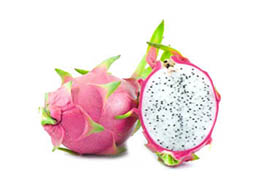 The exotic dragon fruit looks like a Dale Chihuly sculpture or something from another planet, but don’t worry, it’s from Earth! These oblate orbs with their lovely dragon-like scales are native to tropical regions in Mexico, Thailand, and Vietnam, but also grow in Ecuador and parts of the U.S. Dragon fruits grow on vining cactus plants that bloom at night, which is extra magical.
The exotic dragon fruit looks like a Dale Chihuly sculpture or something from another planet, but don’t worry, it’s from Earth! These oblate orbs with their lovely dragon-like scales are native to tropical regions in Mexico, Thailand, and Vietnam, but also grow in Ecuador and parts of the U.S. Dragon fruits grow on vining cactus plants that bloom at night, which is extra magical.
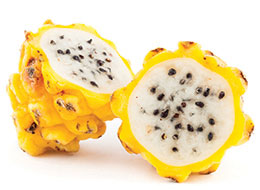
When it comes to eating dragon fruit, fear not the fiery reptilian exterior—underneath you’ll find sweet, mellow white flesh and a smattering of edible black seeds. Cut the fruit in half and scoop out the flesh with a spoon, or score it in both directions inside the peel and scoop out the cubes. Enjoy your antioxidant-rich treat alone or add it to yogurt or salads.
Guavas
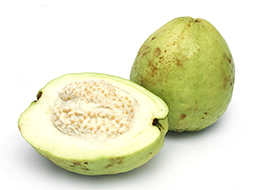
These high-fiber fruits are native to Central America and loaded with vitamin C—four times more than an orange! Even their leaves are good for you. Split open the yellow-green skin of an oval-shaped guava and you’ll discover succulent white flesh. A heady, sweet aroma will drift through the air as you dig in.
You can slice your ripe guava like an apple and eat it out of hand—skin, seeds, and all. If you’re crafty in the kitchen, try this recipe for guayabate (guava paste).
Kiwano Melons

Like dragon fruit, spiky Kiwano melons (also known as horned melons) look more like weapons than fruit. But slice them open, and you’ll discover a sweet and gooey green center reminiscent of their relative, the cucumber.
As KTCHNrebel Magazine so aptly puts it, the Kiwano’s jelly tastes “like an entire fruit cocktail in one, with flavors primarily similar to lime, melon, passion fruit and banana.”
To eat it, slice the spiny fruit in half and spoon out the slippery green pulp inside. This funky fruit is rich in easy-to-absorb iron, vitamin C, and antioxidants, and can also be added to smoothies, salsas, and sauces. It grows in California but is native to Africa.
Want unique fruits for your school?
Kiwi Berries
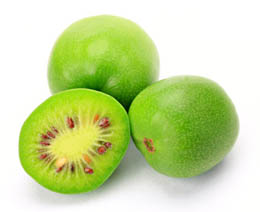 Kiwi berries look like miniature versions of regular-sized kiwis, but they’re fuzzless and best eaten whole, like a grape. They’re power pellets of vitamins and antioxidants, too. Eat them alone as a snack, slice them over yogurt or oatmeal, or add them to a salad. These sweet treats are native to New Zealand.
Kiwi berries look like miniature versions of regular-sized kiwis, but they’re fuzzless and best eaten whole, like a grape. They’re power pellets of vitamins and antioxidants, too. Eat them alone as a snack, slice them over yogurt or oatmeal, or add them to a salad. These sweet treats are native to New Zealand.
Not sure if your kiwi berries are ripe? Look for fruits that are firm or give a bit to gentle pressure. Slightly wrinkled skin signals greater sweetness, but might also mean mushier flesh.
Kumquats
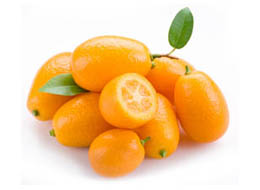
Kumquats are the original sweet-tarts! The “sweet” is in the skin, and the “tart” is in the flesh and juice. To experience the full spectrum of flavor, eat your kumquats whole, like grapes. Try rubbing them gently between your hands before eating to release the sweet oil in their skin.
Don’t want to eat your kumquats by the handful? Try this recipe for kumquat chutney.
Just 5 or 6 kumquats will provide almost two-thirds of your daily recommended intake of vitamin C, which helps prevent neurodegenerative diseases by removing free radicals. These tiny natives of southeast China and Malaysia are also grown in California.
Want rare fruits for your office?
Mandarinquats
The mandarinquat is a hybrid of the mandarin orange and the kumquat. Like kumquats, mandarinquats can be eaten whole, peel and all, but watch out for the seeds! Luckily the sweet, tangy, fiber-rich flesh is well worth the bite.
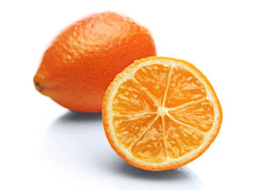
Raw mandarinquats make a delicious snack out of hand but they’re also delectable sliced and used in salads or paired with cheese. You can also cook these tasty tidbits into sauces, purees, and preserves, or bake their peels into fruity breakfast muffins.
This is an extremely rare fruit grown in southern California and only available a few months a year. The FruitGuys often sources mandarinquats from Ripe to You, a family farmer collective in Central California that specializes in unique citrus varieties.
Passion Fruits
 Passion fruit is a vining plant native to Paraguay, Brazil, and Argentina. It also grows in parts of the U.S. including Florida. To get the best possible flavor from your passion fruit, wait until it starts to emit a sweet fragrance and its dark purple skin gets so wrinkled that you’d consider it ready to compost. That’s the perfect time to split the fruit open and reveal its bright yellow center of juicy, jelly-like arils and edible black seeds.
Passion fruit is a vining plant native to Paraguay, Brazil, and Argentina. It also grows in parts of the U.S. including Florida. To get the best possible flavor from your passion fruit, wait until it starts to emit a sweet fragrance and its dark purple skin gets so wrinkled that you’d consider it ready to compost. That’s the perfect time to split the fruit open and reveal its bright yellow center of juicy, jelly-like arils and edible black seeds.
You can think of passion fruit arils as a sweeter, slipperier version of pomegranate arils. They’re rich in vitamins A and C and a good source of potassium and iron. The seeds are also high in dietary fiber—and not to be missed, according to some passion fruit farmers. Use a spoon to scoop them out along with the sweet-tart jelly. You can eat passion fruit plain, add it to baked goods, or blend it into juice.
Want unique fruits for your school?
Pepino Melons
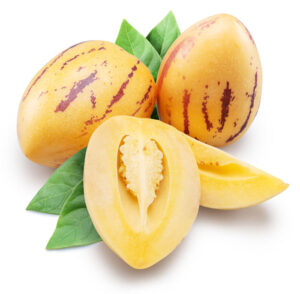
Pepino melons are another Dr. Seuss fruit, featuring an egg-like shape, yellow-green skin, and vibrant purple stripes! Pepinos originally hail from South America and their Spanish name pepino dulce means “sweet cucumber.” They are packed with health benefits and may help reduce inflammation, control heartburn, and even reduce the risk of diabetes and cancer.
Pepino melon skin is edible, though if you find it too tough, you can peel it away. Their taste is a mix of cantaloupe, honeydew melon, and a hint of vanilla custard. Slice the melons into salads as you would a cucumber, or eat them for dessert.
Pichuberries

Pichuberries — also known as ground cherries or Cape gooseberries—are a member of the nightshade family, which includes tomatoes and potatoes. These small green or orange fruits grow wild in the mountains of Peru, Ecuador, and Columbia and are named after Machu Picchu in the Andes Mountains.
Pichuberries grow on vines wrapped in diaphanous husks, similar to tomatillos. Strip off the husks and enjoy their floral, pineapple-like flavor and abundance of crunchy seeds. There’s no need to spit the seeds out; treat them like you would the seeds in a raspberry or strawberry.
Pichuberries are rich in protein, antioxidants, and B vitamins. Eat their sweet-tart flesh raw, chop them into a salsa, or bake them into heavenly muffins.
Variegated Pink Lemons
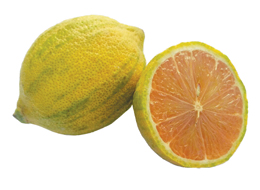 Variegated pink lemons are what ordinary lemons would look like if you dropped them into the world of Dr. Suess. They’re a pink-fleshed Eureka lemon variety from California that develops flashy green and yellow stripes when ripe. Like ordinary lemons, these rare fruits can add bright acidity to rice or pasta dishes, roasted vegetables, and salad dressings.
Variegated pink lemons are what ordinary lemons would look like if you dropped them into the world of Dr. Suess. They’re a pink-fleshed Eureka lemon variety from California that develops flashy green and yellow stripes when ripe. Like ordinary lemons, these rare fruits can add bright acidity to rice or pasta dishes, roasted vegetables, and salad dressings.
Juice half of a pink lemon into a glass of warm water in the morning to help alkalize your system and clear toxins from your liver.
Whether you’re intrigued by pink lemons or kiwi berries, these rare fruits are sure to add color and interest to your late-spring fruit assortment. Don’t miss the opportunity to try them.
Want rare fruits for your office?
Recent Articles
Are Peaches a Citrus? A Farmer Weighs In
Fruit Hybrids, Explained: A Love Story from the Orchard
Subscribe to our Newsletter
"*" indicates required fields





